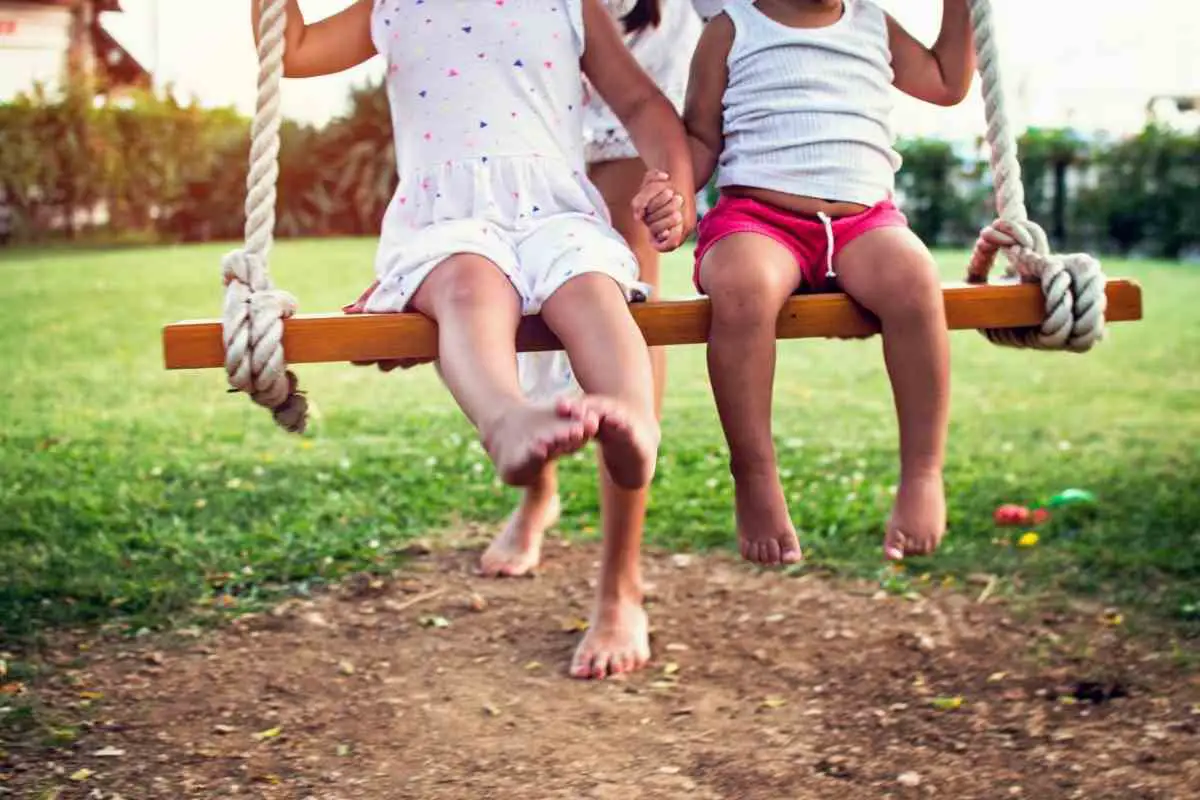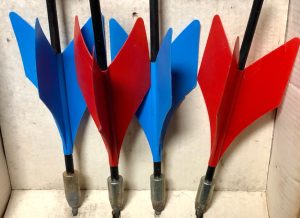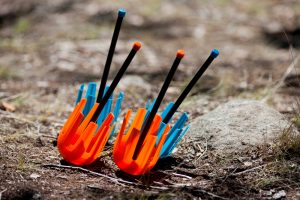Whether you’ve already got a swing set or are considering one for your backyard, you’ll need to think about what to put underneath it.
Though there isn’t a magic substance that guarantees children will be injury-free if they were to fall from a swing, we’re here to talk about the best material to put under a swing set for reducing injury risk.
What to Expect? We’ll cover a range of materials and include the advantages and disadvantages of using each. When deciding what’s best, it’s important to consider safety, maintenance, value, and durability.
Why is it important to consider the material under a swing set?
Even if you’re watching your children closely, you can’t wrap them up in bubble wrap.
Inevitably, there will be a time when someone loses their balance and falls off. They might even decide to jump off or do another crazy stunt as kids do.
Kids can injure themselves just by tripping over their own feet so it’s important to consider the material under a swing set carefully because if they do fall, they’ll potentially be falling from a height.
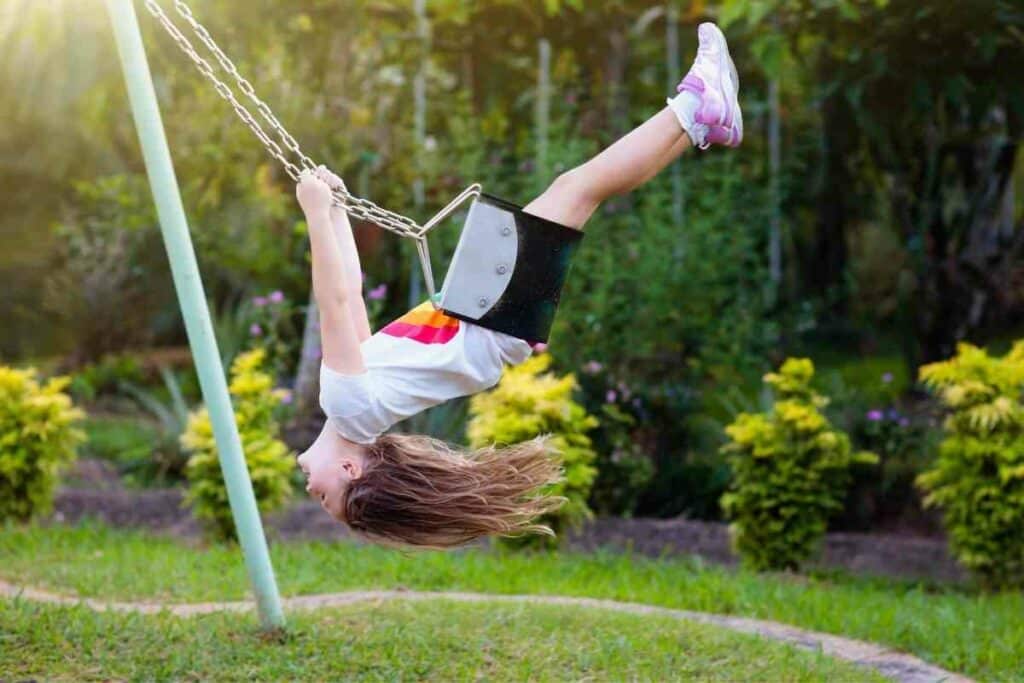
When considering a surface material, you’ll need to make sure it has some shock-absorbing capabilities.
If, for example, you put a swing on a hard surface like concrete, injuries like cuts, bruises, and broken bones are much more likely.
Some types of surfaces will absorb the shocks of falls much better.
As a parent or carer, you want your swing set surface to be a good shock absorber, otherwise, it’s your child’s body that will absorb more of the impact.
There are lots of materials out there for under a swing set. In our guide, we’ll tell you about them all in detail as well as give you our top recommendation.
What is the best material to put under a swing set?
The most popular types of surface material are:
- pea gravel
- wood mulch or chippings
- sand
- grass
- rubber mats
- and rubber mulch
But which material is best?
Our recommendation: If you’re looking for a quick answer, we recommend rubber mulch. If the swing set is for toddlers, you might want to consider rubber mats instead, but this is purely to avoid choking rather than injuries from an impact.
When looking for the best protection against unnecessary injuries, rubber mulch is the material to choose.
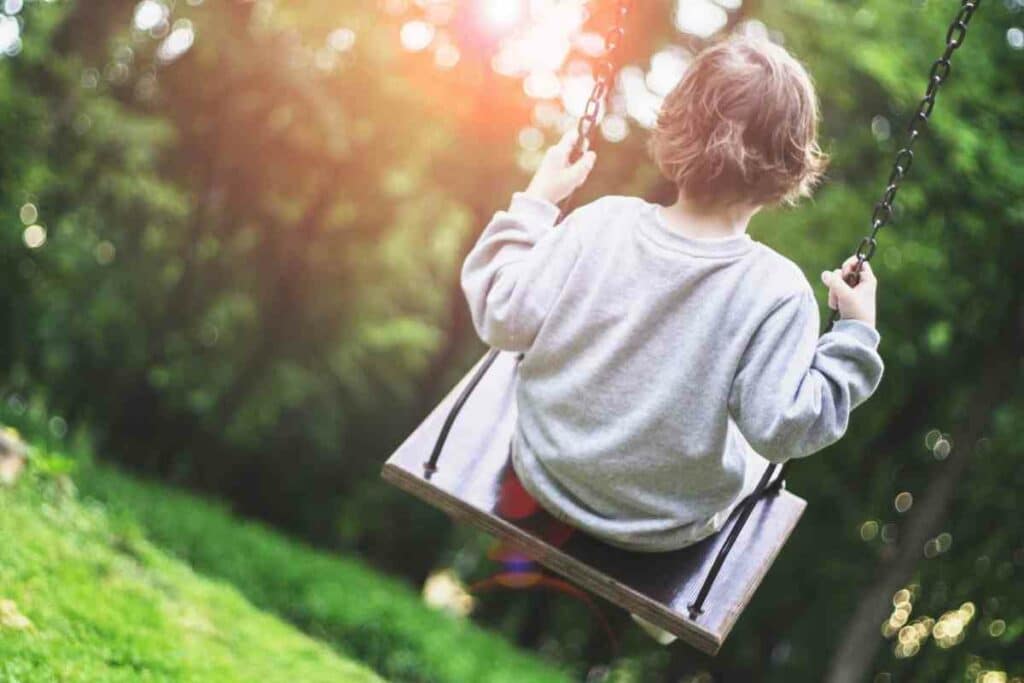
It is more expensive initially, but it lasts a long time and doesn’t need replacing regularly unlike some other materials like sand or wood mulch.
There is also hardly any maintenance needed with rubber mulch!
What do we advise against for swing set surface materials?
All hard and solid materials aren’t suitable for putting underneath a swing set because they have no (or very little) shock-absorbing qualities.
This might come as a surprise but even grass isn’t suitable!
Grass
It’s quite common to find grass under a backyard swing set – normally because it’s already down when a swing set is installed so many people don’t consider anything else.
Unfortunately, grass isn’t a good surface material for under a swing set and there are many reasons why.
First of all, when the weather is dry (which is when a swing set is most likely to be used), the ground becomes rock hard.

This is especially true during the warmer months when it hardly rains, if at all.
As a Result – There is not a lot of protection when kids fall off a swing set onto grass. Grass actually has the lowest resistance to impact of all popular materials for swing set surfaces.
Secondly, when the weather is wet or it has recently rained, grass is really slippery.
This means that when your kids try to get on or off a swing or when they jump off or run around, they’re more likely to slip.
Finally, your grass may look luscious and green in spring when your swing set is installed, but after lots of use, it quickly wears down and you’re left with a hard, dusty (or muddy) patch of ground.
This isn’t a protective surface at all.
If the budget dictates that grass is your only option, be reassured that most of the time (when the ground is moist and isn’t compacted), grass is much safer than asphalt or concrete.
Artificial Grass
Artificial grass is increasing in popularity – it has many of the benefits of grass, but you never have to mow it.
Though you don’t have to mow it, you probably need to wash it from time to time, and it can look out of place in the height of summer when it keeps its lush color and natural grass fades.
As a surface material for a swing set, artificial grass only offers marginally more protection than non-artificial grass.
If you are installing artificial grass and know you’ll be putting a swing set down, you could install some shock-resistance pads under it, but it will still be a hard surface.
Keep in Mind – Artificial grass often drains better so won’t be as slippery when wet. However, it does heat up quite a lot in the sunlight and can cause burns to bare skin. Another deciding factor is how expensive artificial grass is to purchase and install.
Other unsuitable surfaces
When asking yourself what is the best material to put under a swing set, you probably already have an idea of what else isn’t suitable.
Included in the list of unsuitable materials are:
- Flagged paving
- Concrete
- Decking boards
- Asphalt
- Bare dirt (this can become compacted and hard)
All of these materials are not suitable because they have no shock-absorbency.
Surface materials that can be used under swing sets
When considering which material is best under a swing set, you need to consider what is going to be protective and will be long-lasting.
Here are some suggestions with their advantages and disadvantages.
Rubber Mulch
As mentioned above, we recommended rubber mulch as the best material for under a swing set.
This material is often designed especially as a surface material in a kids’ play area, which is why you’ll see it used in lots of public playgrounds.
When choosing this material, you should try to choose one that is designed for playgrounds.
If it’s not designed for playground use, you’ll need to check it thoroughly for any sharp metal pieces which can occur during its manufacture.
If the product meets ASTM F1292 standards, you’ll know it’s safe.
Advantages
- This is the most effective surface material when considering shock absorption. Six inches offers protection from falls as high as ten feet.
- Won’t attract bugs and insects.
- Lowest cost over time – it won’t need replacing because it won’t degrade over time.
- Almost zero maintenance – it just needs the occasional raking over so that it’s evenly distributed.
- It is a great way of recycling old tires.
- It comes in a variety of colors.
Disadvantage
- High initial cost (especially when compared to other loose-fill materials).
- It doesn’t suppress the growth of weeds as well as mulch from wood.
- It is flammable (though fires aren’t common) and will release toxic fumes.
Wood Mulch or Wood Chips
Wood chips are a little better in terms of impact resistance, but wood mulch is much cheaper.
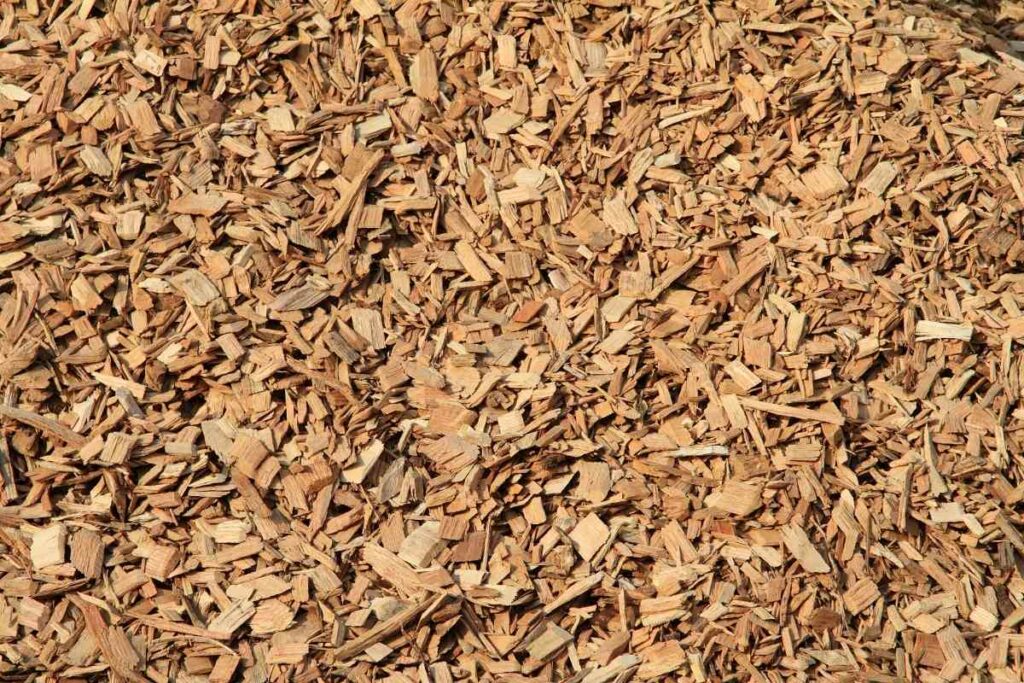
If you find something called EWF (engineered wood fiber), this looks similar, but it is designed specially as a play area surface material.
When looking for wood mulch, if it complies with the ASTM F2075 safety standard, you know it is safe in terms of playground use.
You should be careful when choosing wood mulch and make sure it hasn’t been created with pressure-treated wood using CCA (chromated copper arsenate) as this is not safe.
Advantages
- 9” of wood mulch offers protection from a seven-foot fall, while the same amount of wood chips offers 10 feet protection.
- It drains well and will absorb rainwater.
- It is not slippery.
- Cheaper initially than rubber mulch.
- Readily available.
- Easy to fix back into position with a rake.
- Has a natural color and looks good in a garden.
- Will help to control weeds.
- It is environmentally friendly.
Disadvantages
- It needs to be topped up regularly.
- Children can get splinters.
- It needs to be topped up regularly.
- It is displaced easily in areas of high traffic.
- It can attract insects.
- It sometimes goes moldy.
- It freezes in cold temperatures, which makes it less safe.
Pea gravel
Pea gravel for under a swing set is cheap, offers great drainage, and is available in a range of places.
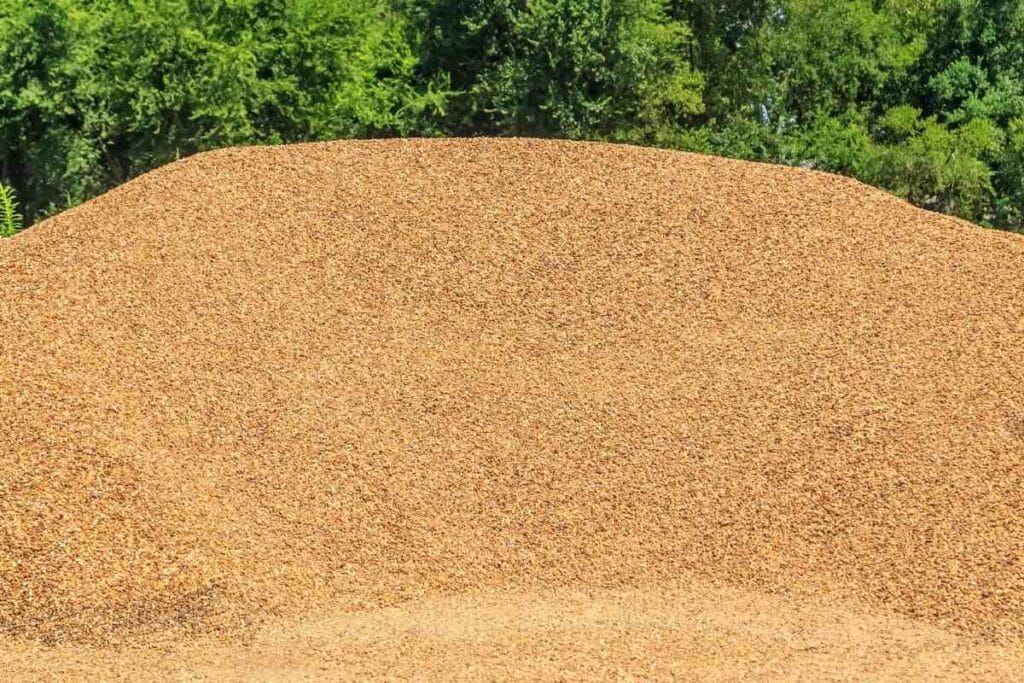
However, it doesn’t offer much in the way of shock absorbency.
Though it looks nice in a backyard, it will probably need topping up regularly.
Advantages
- It is clean (it is washed when it rains).
- It won’t have microbial organisms growing in it.
- It is cheap.
- It is a natural product that looks good in gardens.
- It is durable.
- It will stay in place more than sand.
Disadvantages
- It isn’t as effective as other loose-fill materials in terms of shock absorbency. Nine inches will only offer protection from falls of five feet (but this is probably enough for a swing set).
- It’s difficult for anyone with mobility problems to move on.
- Wildlife or local cats might use it as a toilet.
- It can break up into small pieces, which could make for a harder landing surface.
- It will need to be replaced more often (but not as much as sand).
- It is easily scattered and requires maintenance (regular raking) to keep it even.
Sand
Sand is a good material and it’s also cheap.
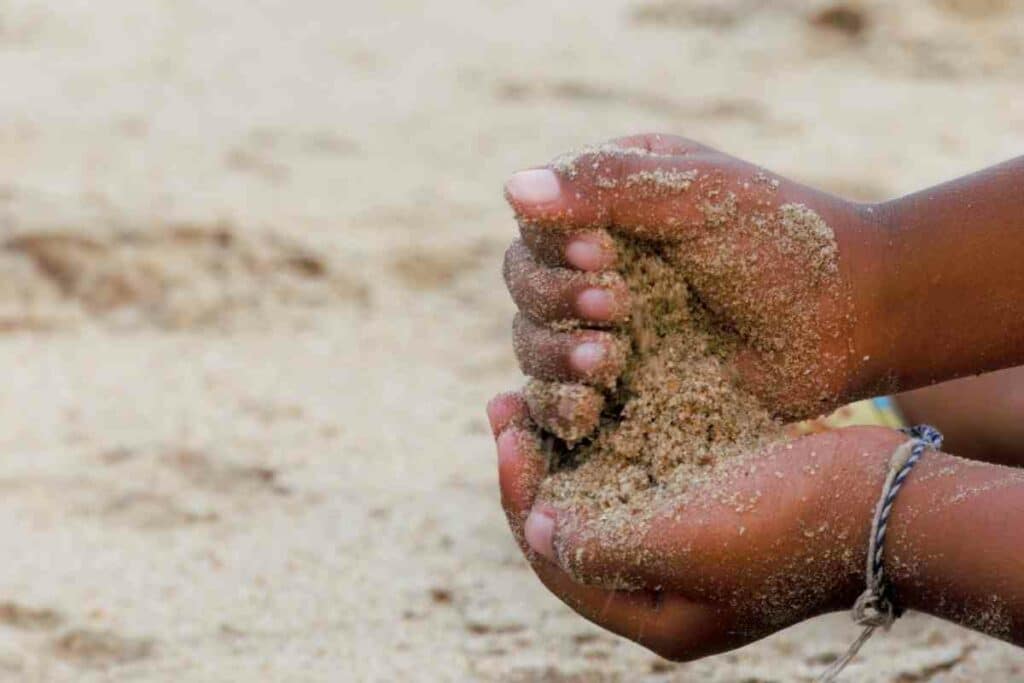
You should make sure to use play sand and not building sand, however.
It doesn’t offer much shock absorbency compared to other loose-fill materials though.
Advantages
- It is cheap.
- It is readily available.
- It is a natural product that looks great in gardens.
- It can double up as a sandbox.
Disadvantages
- 9” will only protect falls four-foot falls.
- Gets hard when it’s damp (and so offers less protection).
- Difficult to move on if you have reduced mobility.
- Might end up being used as a litter box.
- It attracts bugs like ants.
- It can scatter or blow away.
- Needs frequent topping up and raking.
Final thoughts – what is the best material to put under a swing set?
When choosing a material for under your kids’ swing set, you want something that’s safe.
In terms of protection, rubber mulch comes top of the list.
That’s not to say there aren’t other alternatives that are better suited to you and your family.
Hopefully, this guide has provided an insight into the pros and cons of swing set surface materials to help you make your final decision.
